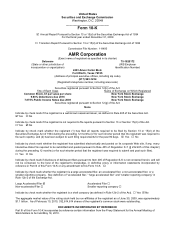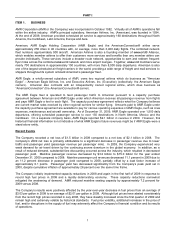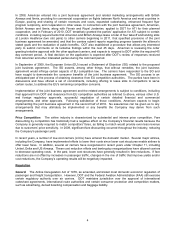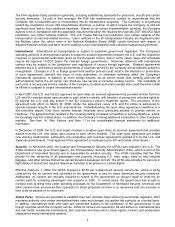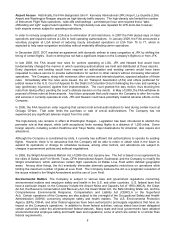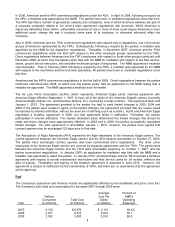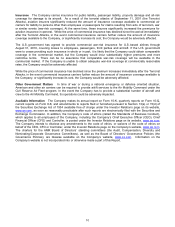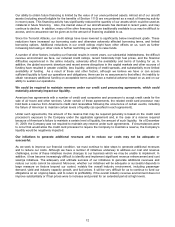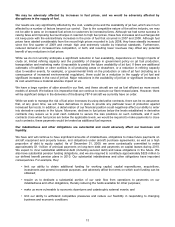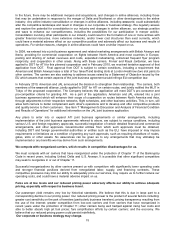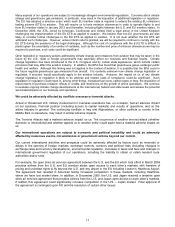American Airlines 2009 Annual Report Download - page 12
Download and view the complete annual report
Please find page 12 of the 2009 American Airlines annual report below. You can navigate through the pages in the report by either clicking on the pages listed below, or by using the keyword search tool below to find specific information within the annual report.
9
The impact of fuel price changes on the Company and its competitors depends on various factors, including
hedging strategies. The Company has a fuel hedging program in which it enters into jet fuel and heating oil
hedging contracts to dampen the impact of the volatility of jet fuel prices. During 2009, 2008 and 2007, the
Company’s fuel hedging program increased (decreased) the Company’s fuel expense by approximately $651
million, ($380) million and ($239) million, respectively. As of January 2010, the Company had cash flow hedges,
with option contracts, primarily heating oil collars and call options, covering approximately 24 percent of its
estimated 2010 fuel requirements. The consumption hedged for 2010 by cash flow hedges is capped at an
average price of approximately $2.48 per gallon of jet fuel, and the Company’s collars have an average floor price
of approximately $1.80 per gallon of jet fuel (both the capped and floor price exclude taxes and transportation
costs). A deterioration of the Company’s financial position could negatively affect the Company’s ability to hedge
fuel in the future. See the Risk Factors under Item 1A for additional information regarding fuel.
Additional information regarding the Company’s fuel program is also included in Item 7(A) ―Quantitative and
Qualitative Disclosures about Market Risk,‖ Item 7 ―Management’s Discussion and Analysis of Financial Condition
and Results of Operations‖ and in Note 7 to the consolidated financial statements.
Frequent Flyer Program
American established the AAdvantage® frequent flyer program (AAdvantage) to develop passenger loyalty by
offering awards to travelers for their continued patronage. The Company believes that the AAdvantage program is
one of its competitive strengths. AAdvantage benefits from a growing base of approximately 64 million members
with desirable demographics who have demonstrated a strong willingness to collect AAdvantage miles over other
loyalty program incentives and are generally disposed to adjusting their purchasing behavior in order to earn
additional AAdvantage miles. AAdvantage members earn mileage credits by flying on American, American Eagle,
and the AmericanConnection® carrier or by using services of other participants in the AAdvantage program.
Mileage credits can be redeemed for free, discounted or upgraded travel on American, American Eagle or other
participating airlines, or for other awards. Once a member accrues sufficient mileage for an award, the member
may book award travel. Most travel awards are subject to capacity controlled seating. A member’s mileage credit
does not expire as long as that member has any type of qualifying activity at least once every 18 months.
American sells mileage credits and related services to other participants in the AAdvantage program. There are
over 1,000 program participants, including a leading credit card issuer, hotels, car rental companies and other
products and services companies in the AAdvantage program. The Company believes that program participants
benefit from the sustained purchasing behavior of AAdvantage members, which translates into a recurring stream
of revenues for AAdvantage. Under its agreements with AAdvantage members and program participants, the
Company reserves the right to change the AAdvantage program at any time without notice, and may end the
program with six months notice. As of December 31, 2009, AAdvantage had approximately 64 million total
members, and 600 billion outstanding award miles. During 2009, AAdvantage issued approximately 175 billion
miles, of which approximately two-thirds were sold to program participants. See ―Critical Accounting Policies and
Estimates‖ under Item 7 for more information on AAdvantage.
In 2009, American entered into an arrangement under which an affinity partner pre-purchased AAdvantage miles
from American as further discussed in Note 6 to the consolidated financial statements.
Other Matters
Seasonality and Other Factors The Company’s results of operations for any interim period are not necessarily
indicative of those for the entire year, since the air transportation business is subject to seasonal fluctuations.
Higher demand for air travel has traditionally resulted in more favorable operating and financial results for the
second and third quarters of the year than for the first and fourth quarters. Fears of terrorism or war, fare
initiatives, fluctuations in fuel prices, labor actions, weather and other factors could impact this seasonal pattern.
Unaudited quarterly financial data for the two-year period ended December 31, 2009 is included in Note 15 to the
consolidated financial statements. In addition, the results of operations in the air transportation business have
also significantly fluctuated in the past in response to general economic conditions.



